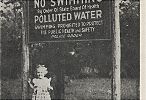While today we understand that cholera and typhoid are both bacterial diseases and that polio is a viral disease, Chicagoans fought them without this basic knowledge across the nineteenth and into the twentieth centuries. Instead, Chicagoans looked for patterns of epidemic outbreaks and sought ways to prevent the conditions surrounding those outbreaks. Without the aid of germ theory, nineteenth-century public health officials, physicians, and engineers determined that control of water supply and wastewater were crucial to checking these epidemics.
Although they were not the only diseases related to polluted water supply and inadequate sanitation, cholera, typhoid, and polio followed one after the other in Chicago, as sanitarians sought to protect residents from them. Over time, sanitarians found that cholera could be controlled by better water supply. Improving water supply, however, led to more wastewater in and around Chicago, which increased the incidence of typhoid fever. While better plumbing and sanitation helped control typhoid fever, it reinvigorated an old disease like polio, as residents lost what had been a natural immunity to the disease.
Photo Essay Sections:
|
|
|
|
The Encyclopedia of Chicago © 2004 The Newberry Library. All Rights Reserved. Portions are copyrighted by other institutions and individuals. Additional information on copyright and permissions.


